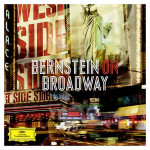|
Back
05/01/2018
“Bernstein on Broadway”
Leonard Bernstein: Excerpts from West Side Story [1] – On the Town [2] – Candide [3]
West Side Story: Kiri Te Kanawa (Maria), José Carreras (Tony), Tatania Troyanos (Anita), Marilyn Horne (“Somewhere”), Louise Edeiken (Rosalia), Angelina Réaux, Stella Zambalis (girls), Leonard Bernstein (conductor)
On the Town: Tyne Daly (Hildy), Frederica von Stade (Claire), David Garrison (Gabey), Kurt Ollmann (Chip), Thomas Hampson (Ozzie), London Voices, Terry Edwards (choral master), Michael Barrett (piano), London Symphony Orchestra, Michael Tilson Thomas (conductor)
Candide: June Anderson (Cunegonde), Della Jones (Paquette), Christa Ludwig (Old Lady), Nicolai Gedda (governor), Adolph Green (Dr. Pangloss), Jerry Hadley (Candide), Kurt Ollmann (Maximilian), London Symphony Chorus and Orchestra, Simon Joly (chorus master), Leonard Bernstein (conductor)
Recordings: RCA Studio A, New York City, New York (September 1984) [1]; Barbican Centre, London, England (June 1992) [2]; Abbey Road, Studio No. 1, London, England (December 1989) [3] – 70’23
Deutsche Grammophon 479 9834 – no booklet

   
Orchestras around the world are celebrating the music of Leonard Bernstein, in this, his centenary year. Deutsche Grammophon has released several new collections including “Bernstein on Broadway” with the composer himself conducting excerpts from West Side Story and Candide as well as a live concert recording of On the Town conducted by Michael Tilson Thomas.
It is a revisit to Bernstein’s imprimatur as a key player in what proved to be the golden age of the American musical. It is instructive to hear the detailing Bernstein gives to his own theater music, a reminder of what a uniquely singular compositional voice was to the American musical theater. And, hearing them together, these recordings also reveal his compositional limitations in theatrically stylized forms.
Bernstein’s concert hall staple Symphonic Suite from West Side Story never loses its intoxicating appeal for musicians or audiences. But it doesn’t supplant the richness and daring of the original score. It is easy to get swept away again into Bernstein’s Broadway melodies with West Side Story selections from his 1984 studio recording starring opera stars Kiri Te Kanawa, José Carreras and Marilyn Horne. You hear a more organic drive from the first song, “Mambo”, the geometric thrust of the percussion for starters. It was the first time Bernstein had conducted West Side Story, and a documentary film captured all of the tension of the precision Bernstein insisted on...“You got to get that gutsy feeling”, Bernstein noted.
With Bernstein conducting a studio orchestra, the tempos, for starters, are in fact a revelation, yet they don’t sound like a musical theater pit band and the lushness doesn’t go into the strings as often happens in the concert hall with a symphony orchestra. It’s a shame that musicians are not listed in the CD’s credits because they definitely deliver the full dimension of West Side Story’s orchestral score.
Bernstein symphonic subtlety is so in sync with these singers even though the casting of Carreras was controversial because he didn’t fit the image of Tony. His accent now, is, rightly, a non-issue, but at the time the recording was widely criticized. Referenced in Humphrey Burton’s Bernstein biography, the composer’s tensions boiled over as Carreras struggled to erase his accent, and Bernstein became impatient.
But even though the “lapse in verisimilitude was more than compensated for in Bernstein’s mind, for the opportunity to have his only romantic love music, sung by two of the world’s most sumptuous voices, accompanied by a large, more virtuosic orchestra.” Carreras struggles mostly with the already tricky “Something’s Coming”, but Carreras’ tenor prowess is in full bloom during “Maria.” Then there is the full balcony scene that leads into “Tonight” where, needless to say, Carreras and Te Kanawa completely captivate. Oddly missing in this recording is their great performance of the ballad “One Hand, One Heart.” At the time, this recording was controversial, but [to me] so many opera singers who attempt Broadway musicals do so with technical artistry, yet fail to emotionally connect with the role. That is not an issue here.
It’s hard not to hear Frank Sinatra, Gene Kelly and Jules Munchin on the docks singing “New York, New York” in the film version of On the Town. But David Garrison, Thomas Hampson and Kurt Ollman have the vocal swagger to make it their own. Tyne Daly, sounding Merman-snarky in the “Taxi number”, makes the most of Bernstein’s Tin-Pan Alley blues vamp. Hampson’s lilting bass is charming enough in Bernstein’s filler number “Lucky To Be Me” with the chorus floating around like decorous holdouts from the Ziegfeld Follies. “You Got Me” is a forgettable novelty number right out of the MGM Comden and Green trunk.
Will Bernstein’s Candide ever get its full due praise? This brilliant modern operetta is way ahead of its time, and it only played on Broadway for two months. Of course, it is hard to beat the original cast headed up by the breakthrough performance of Barbara Cook, but with Bernstein conducting the London Symphony Orchestra (LSO) and Chorus along with soprano June Anderson and tenor Jerry Hadley, it is, in fact, just as magical. The sharpness and thrust of Bernstein conducting Bernstein ignites the LSO which blazes from the first notes of the “Overture”, bringing forth majesty and buffa dimensions à la Offenbach. From the vocal minuet, “Life is Happy”, to the Italianate classical charm of “Oh, Happy We”, Hadley and Anderson have shimmering vocal charm.
Anderson’s sparkling soprano is so right for “Glitter and Be Gay”, the buffa seria that slides into a sultry rumba and boils over into the fireworks of trills and orchestral gallops. And during “Make Our Garden Grow” Bernstein’s lush symphonic bursts forth with a hope for humanity that is in the same musical theater class as “Somewhere.”
Lewis J. Whittington
|